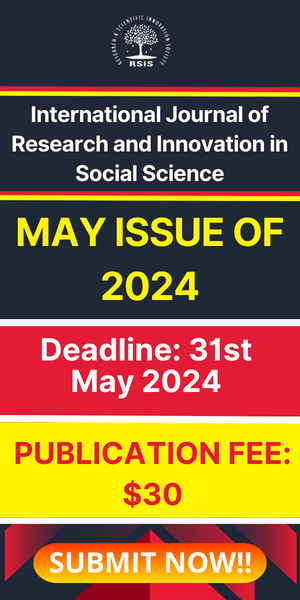Adsorptive Characteristics of Coag-flocculation Studies of Carica papaya Leaf Protein Isolate in Paint Industry Effluent Medium
- April 30, 2019
- Posted by: RSIS
- Category: Chemical Engineering
International Journal of Research and Scientific Innovation (IJRSI) | Volume VI, Issue IV, April 2019 | ISSN 2321–2705
Anagwu Ifeanyi Festus1*, Onukwuli Okechukwu Dominic2, Obiora-Okafo Ifeoma Amaoge3, Nze Michael Soronnadi1
1*Department of Chemical Engineering, Federal Polytechnic, Nekede, Owerri, Nigeria
2Department of Chemical Engineering, Nnamdi Azikiwe University, Awka, Nigeria
3Department of Chemical Engineering, Madonna University, Nigeria
1*Corresponding Author
Abstract:- The aim of this study is to explore the potential of Carica papaya leaf proteinisolate as an adsorbate applicable in wastewater treatment. The protein content of Carica papaya leaf was fully isolated by precipitation adopting the method of salting out and re-solubilisation in distilled water to obtain pawpaw leaf protein concentrate also known as pawpaw leaf coagulant (PLC). The phytochemical analysis of the PLC indicated its potency as an adsorbate applicable in industrial effluent coag-flocculation where the colloidal particles within the effluent medium are the adsorbent.The effluent used in this study was paint industry effluent (PIE). The adsorption of PLC onto the colloidal particles, triggering particles aggregation and subsequent agglomeration, were studied varying the adsorbate dose, solution pH and contact time. The highest turbidity percentage removal of 99.5% were obtained at contact time of45 minutes, solution pH of 6.0 and dosage of 300 mg/l at room temperature. It was also discovered that the colour of the paint effluent, as a result of the treatment, reducedfrom 2015 PCU to 200 PCU while total solids dropped from 1600 mg/l to 122 mg/l. The trend indicates that at 4, the sorption of PLC is more favourable. Adsorption isotherms – Langmuir, Freindlich, Tempkin and Henry – were plotted and the data were found to be best represented by the Henry isotherm, having coefficient of determination, R2 of 1. This is followed by Langmuir isotherm with R2 of 0.9978. Adsorption kinetics studies favoured pseudo-second order kinetic model. It is concluded that Carica papaya leaf protein isolate is a useful adsorbate capable of initiating particles agglomeration in an effluent medium prior to gravity settling and detoxification.
Keywords: pawpaw leaf coagulant, coag-flocculation, adsorbate, adsorption isotherms.


